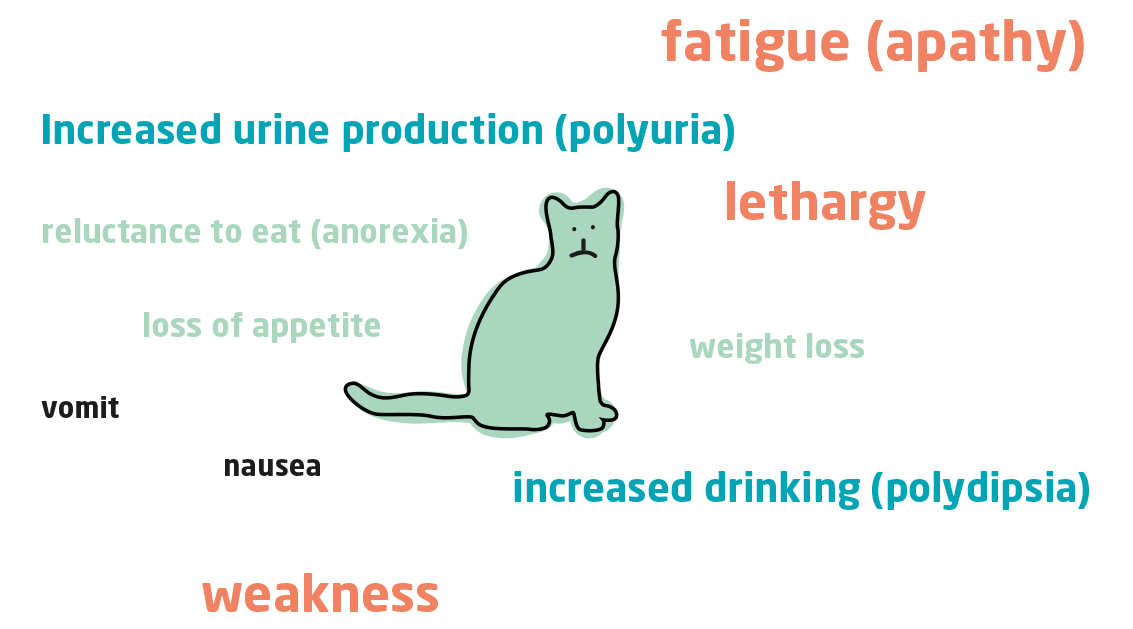Clinical symptoms of CKD
The clinical symptoms of CKD are as diverse and numerous as the functions of the kidney. In addition, each cat has its own individual kidney-related vulnerability. That means that every cat presents a different pattern of symptoms and not every symptom occurs in every cat.
Mostly, the symptoms appear gradually over weeks, months and years and are often only noticed when 2/3 to 3/4 of the nephronsNephrone sind die Filtereinheiten der Nieren.... have already been destroyed.
Many of the known symptoms have several causes. And some clinical symptoms are also interrelated. For example, nausea leads to an aversion to eating, which in turn leads to emaciation and, ultimately, bodily weakness. Weakness, in turn, can cause a cat to become “wobbly” on its legs, which is also apparent in the hind limbs (hind-limb weakness).
Vomiting can exacerbate dehydrationA deficit of total body water. Dehydration can be caused by excessive fluid loss, for instance via the kidneys in CKD, or by insufficient fluid intake..... Inflammation of oral mucous membranes and peptic ulcers can lead to malnutrition and nausea.
AnorexiaLoss of appetite, aversion to eating, in veterinary medicine also referred to as inappetence...., apathyIndifference, listlessness, lethargy, weakness and weight loss as well as increased drinking (polydipsiaExcessive thirst due to illness, leading to excessive production of urine (polyuria)....) and excessive urine production (polyuriaExcessive production of urine, potentially due to kidney failure....) are the main symptoms of chronic kidney disease (CKD).
Most symptoms are easily treated. Reducing their causes, in particular, is effective in alleviating clinical symptoms. It constitutes an important part of treatment.
The main symptoms of chronic kidney disease (CKD) are listed below.

Consequences of renal insufficiency in CKD

Regulation of water balance
Loss of the ability to reabsorb water and loss of regulation of salt and other electrolytes in the body.
- Increased drinking (polydipsia)
- Increased urine production (polyuria)
- Dehydration → until collapse
- Fatigue (apathy), weakness, lethargy
- Accumulation of fluid in tissues (oedemaExcess fluid collecting in the tissues of the body, which can cause them to become swollen....)
- Increased blood pressure (hypertensionHigh blood pressure.)
Regulation of electrolyte balance
Loss of fine regulation of the electrolyte balance can lead to secondary hyperparathyroidism
- Lack of appetite (anorexia)
- Fatigue (apathy), weakness, lethargy
- Weight loss
- Itchiness
- Twitching
- Teeth grinding
- Impaired movement (for example weakness of the hind legs) and abnormal movements like walking on hocks (plantigrade gaitA “bear-like” gait. Cats walking with a plantigrade gait don’t walk on their paw tips, but with their metatarsal bones and hocks (ankles) on the ground. Typically occurs in cats with diabetes....), uncoordinated movements
- Constipation
- Eating cat litter
- Hypothermia
Regulation of pH balance
The loss of fine regulation of pH in the body can lead to increased acidity of the blood (metabolic acidosis)
- Weight loss and muscle atrophyWasting away of tissue, a reduction in the volume and/or size of tissues or organs....
→ spine becomes visible and bony - Breathlessness, increased panting
- Mucosal ulcers in the mouth (stomatitisA site of inflammation of the mouth mucosa.)
- Vomiting
Production of hormonal substances
Reduced calcitriol production (vitamin D)
A decrease in calcitriol production can lead to secondary hyperparathyroidism.
Disruption of renin synthesis
Disruption of renin synthesis can be associated with high blood pressure.
- Central nervous disorders such as seizures, convulsions, lethargy, stroke
- Walking difficulties
- Visual disorders → blindness due to retinal detachment
- ProteinuriaIncreased protein in urine, leading to loss of protein. Normally, only a very small amount of protein is excreted in the urine. In chronic kidney disease, the amount lost may increase. High blood pressure damages blood vessels in the nephrons making them more permeable and...
Reduction in erythropoietin synthesis
Disruption of erythropoietin synthesis can lead to anaemia
- Fatigue (apathy), weakness, lethargy → hind leg weakness
- Lethargy
- Paleness of the mucous membrane of eyes, ears and mouth
- Hypothermia, cat cold to the touch, feels cold, shivers
- Nausea, lack of appetite (anorexia), eats cat litter
- Increased heart and breathing rate
Removal of toxins
- Diarrhoea → emaciation, dehydration
- Shaggy coat
- Fatigue (apathy)
- Stomach ulcers which can lead to bleeding
- Tremor, cramps, abnormal movements, muscle disorders, comatose states
